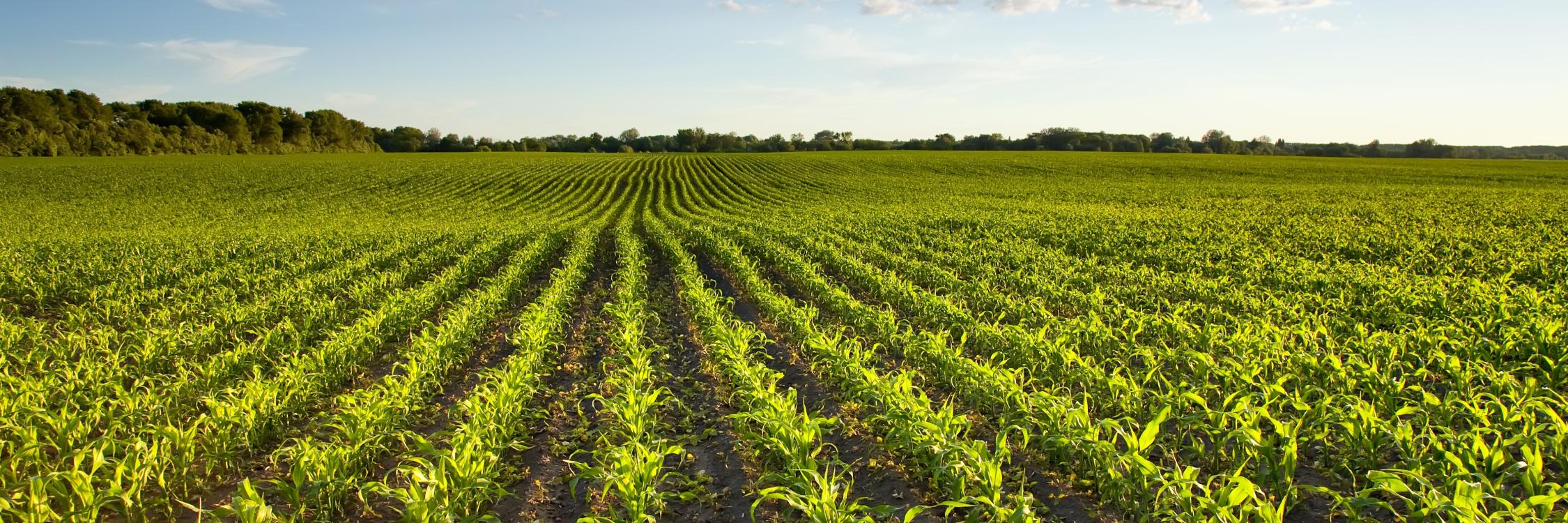
Boost Early Season Plant Growth with Starter Fertilizers
Seeds are sensitive, how you apply K-Row 23 will determine how well you are nurturing them.
A sustainable nutrient management program begins with the “4 R’s” (applying the right source of nutrient, in the right place at the right rate and the right time). Starter fertilizer applications can be one key component to a successful growing season by giving growing seedlings access to available nutrients to further boost growth. It has been shown that banding fertilizers closer to the plant roots often improves nutrient use efficiency by increasing nutrient uptake and thus helps reduce fertilizer cost. When it comes to the placement of starter fertilizers, placement of the fertilizer in relation to the seed can vary depending on equipment availability, crop type, and fertilizer blend. Below in Figure 1 is an illustration describing various placement methods of starter fertilizers in relation to the seed. When placing fertilizer in-furrow, special precautions must be made to avoid negative impacts on crop germination. This means ensuring fertilizer sources have lower salt indexes and applying reduced rates of the material or materials in furrow. This is especially true when it comes to nitrogen and potassium rates and the chemical makeup of those materials. Keep in mind that crops differ in their sensitivity to in-furrow starters as well.
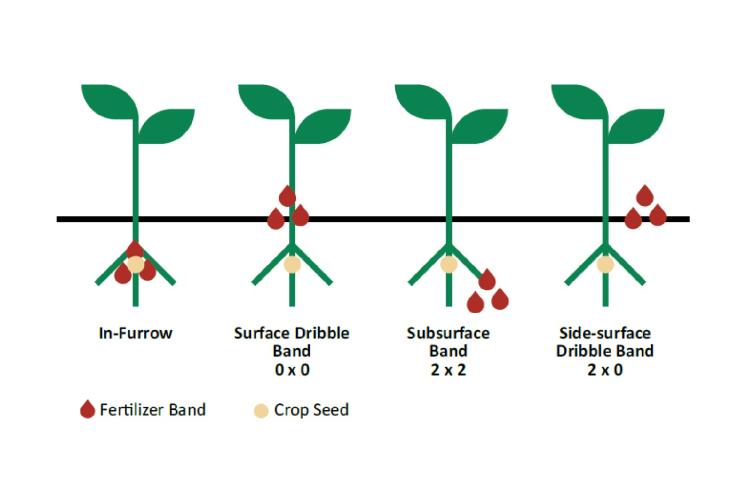
Figure 1.
Illustration of different placement options for starter fertilizers.
Why K-Row 23?
K-Row 23 (0-0-23-8S) is a liquid sulfur and potassium fertilizer solution for your at planting nutrient needs. The chemistry of our product allows growers to apply it safely both in-furrow and out of furrow in numerous starter fertilizer blends on several crops including corn and soybean. Starter fertilizers are critical to enhance crop establishment and growth. A well-balanced starter blend allows plants to access valuable nutrients right away as they begin growth. Nutrients like phosphorus are important at this time to increase vegetative growth for crop establishment. Sulfur starter applications are also vital to limit early season sulfur deficiencies and assist with nitrogen utilization in the plant. As corn and even soybean planting dates continue to move earlier in much of the Midwest, soil temperatures at planting are often cooler leading to less early season sulfur mineralization from organic matter. Supplying a soluble sulfur source in-furrow or next to the furrow allows plants to access needed sulfur early in the season when it may not be as available in the soil. Consult with your local agronomist or Crop Vitality Specialist to determine appropriate starter blends and rates for your crop nutrient plan.
Contact a SpecialistApplication Recommendations
In-Furrow:
Corn:
- By itself apply 1 to 5 GPA of K-Row with the seed. In sandy or dry soil, apply a reduced rate of 0.5 to 2.5 GPA.
- In combination with APP, apply up to 80 lbs of blended product (7.0 gallons) per acre in heavy soils with no more than 5 GPA of APP.
- In sandy textured soils or dry conditions, apply up to 40 lbs (3.5 GPA) of mixed product.
Soybean:
- For irrigated soybeans on 30” rows, apply 2-4 GPA of K-Row alone and irrigate after planting.
- For dryland soybeans on 30” rows., apply 1-2 GPA of K-Row alone with the seed in good soil moisture.
2X2 Application:
Corn:
- Apply 1-8 GPA of K-Row 23 with or without APP. In lighter texture soils or moisture limited conditions, reduce the rate by 50%.
Soybean:
- Apply 1-6 GPA of K-Row 23 with or without APP. In lighter texture soils or moisture limited conditions, reduce the rate to 0.5 -2.5 GPA.
Product Compatibility
- K-Row 23 readily blends with APP in any ratio.
- When blending K-Row 23 with UAN, water needs to be added to the blend to equal the weight of K-Row 23 or UAN in the final mix. Blending order to be followed is: K-Row 23 – Water – UAN.
- Always do a jar test when blending new mixes.
Example of Starter Fertilizer Blend Options
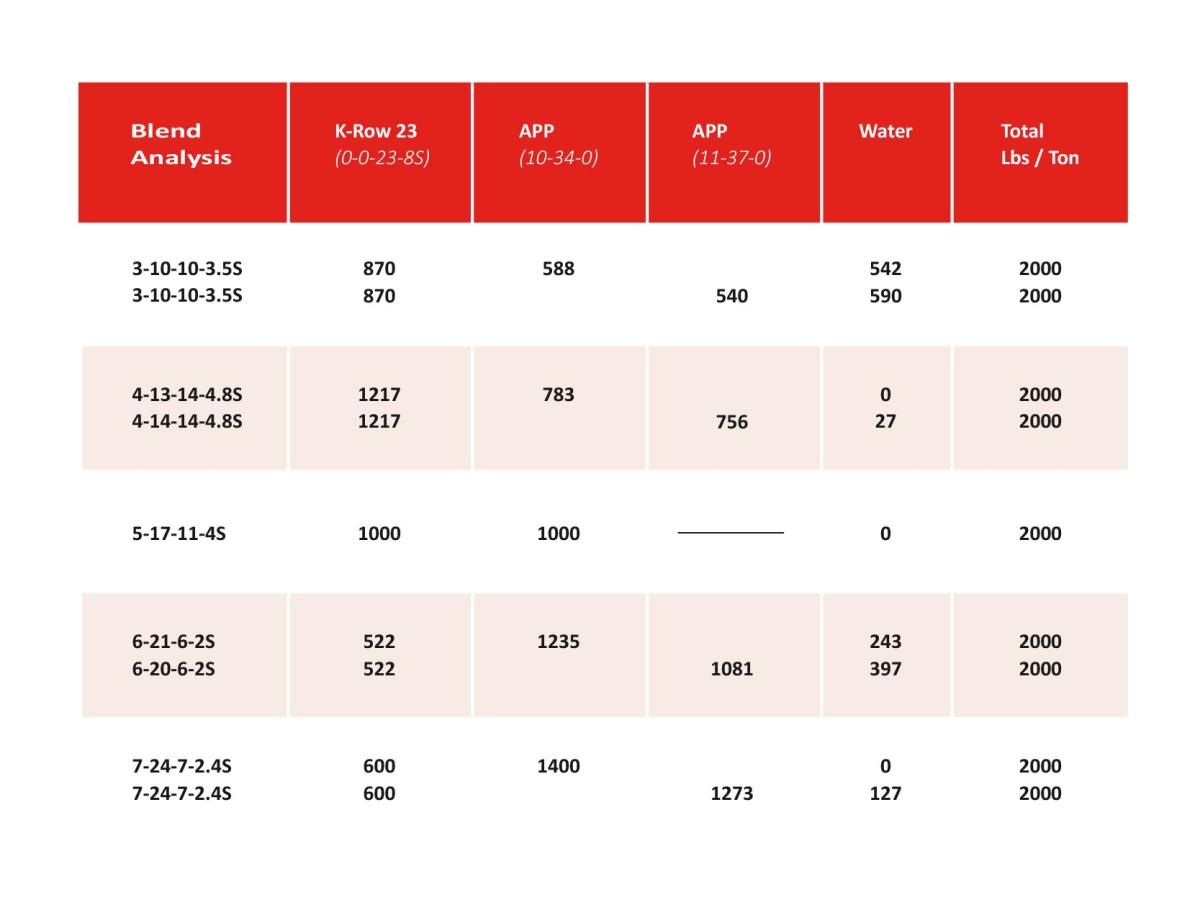
Research Findings

Figure 2.
This study by South Dakota State University evaluated the seed sensitivity of corn with various starter fertilizers. As you can see the chemistry advantages of K-Row 23 greatly outperformed other starter fertilizer blends. It resulted in the least germination damage of all blends evaluated.
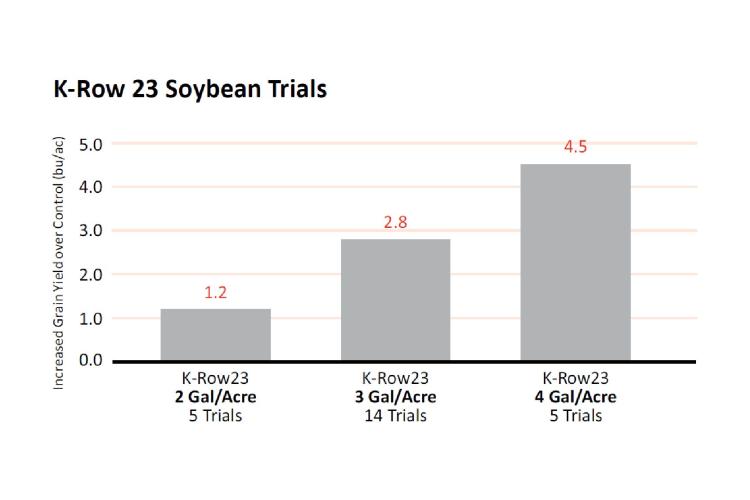
Figure 3.
Average soybean yield response to various rates of K-Row 23 across the Midwest.
K-Row 23 Soybean Trial Highlights:
- All trials conducted with K-Row 23 alone.
- Soil moisture conditions can influence availability and efficacy regardless of soil type or crop.
Summary
- Starter fertilizers are an important component of a nutrient management program to give plants access to critical nutrients in early stages.
- Using banded placement of starter fertilizers can improve nutrient use efficiencies.
- K-Row 23 provides soluble potassium and sulfur to meet early season nutrient needs and can be blended with APP in any ratio to create balanced starter fertilizer blends.
- K-Row 23 can be applied in-furrow on both corn and soybean as well as other crops.
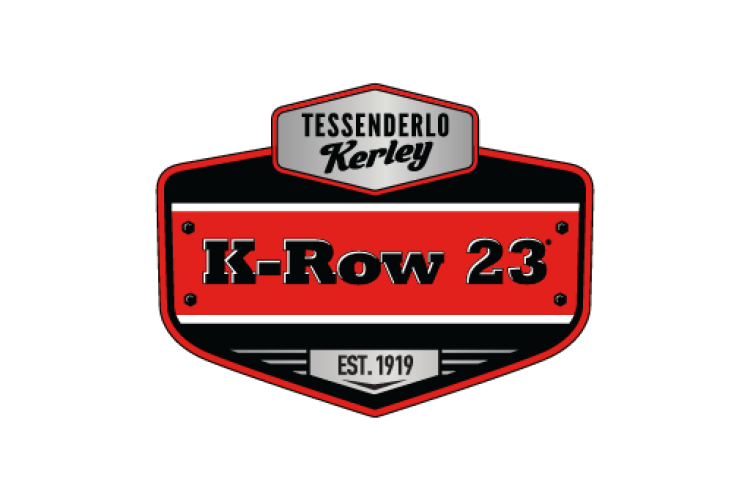
K-Row 23
- Potassium and Sulfur
- Supplies a seed-safe form of sulfur and potassium at germination
- Offers a low salt-out temperature, critical for early season planting conditions
- Enables greater exposure to nutrients as compared to other fertilizers or supplements
- Can blend K-Row 23 with UAN when including equal parts by weight of water and K-Row 23
- Can blend K-Row 23 with ammonium polyphosphate solutions (e.g. 10-34-0, 11-37-0)
- Multiple application methods are available
- 0-0-23-8S
Written by Dr. Elizabeth Lemings, Crop Vitality, Tessenderlo Kerley Agronomist
Contact a Specialist